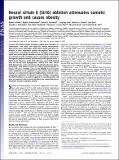Neural sirtuin 6 (Sirt6) ablation attenuates somatic growth and causes obesity
Author(s)
Schwer, Bjoern; Schumacher, Bjoern; Lombard, David B.; Xiao, Cuiying; Kurtev, Martin V.; Gao, Jun; Schneider, Jennifer I.; Chai, Hua; Bronson, Roderick T.; Tsai, Li-Huei; Deng, Chu-Xia; Alt, Frederick W.; ... Show more Show less
DownloadSchwer-2010-Neural sirtuin 6 (Sirt6) ablation attenuates somatic growth and causes obesity.pdf (896.9Kb)
PUBLISHER_POLICY
Publisher Policy
Article is made available in accordance with the publisher's policy and may be subject to US copyright law. Please refer to the publisher's site for terms of use.
Terms of use
Metadata
Show full item recordAbstract
In yeast, Sir2 family proteins (sirtuins) regulate gene silencing, recombination, DNA repair, and aging via histone deacetylation. Most of the seven mammalian sirtuins (Sirt1–Sirt7) have been implicated as NAD+-dependent protein deacetylases with targets ranging from transcriptional regulators to metabolic enzymes. We report that neural-specific deletion of sirtuin 6 (Sirt6) in mice leads to postnatal growth retardation due to somatotropic attenuation through low growth hormone (GH) and insulin-like growth factor 1 (IGF1) levels. However, unlike Sirt6 null mice, neural Sirt6-deleted mice do not die from hypoglycemia. Instead, over time, neural Sirt6-deleted mice reach normal size and ultimately become obese. Molecularly, Sirt6 deletion results in striking hyperacetylation of histone H3 lysine 9 (H3K9) and lysine 56 (H3K56), two chromatin marks implicated in the regulation of gene activity and chromatin structure, in various brain regions including those involved in neuroendocrine regulation. On the basis of these findings, we propose that Sirt6 functions as a central regulator of somatic growth and plays an important role in preventing obesity by modulating neural chromatin structure and gene activity.
Date issued
2010-12Department
Massachusetts Institute of Technology. Department of Brain and Cognitive Sciences; Picower Institute for Learning and MemoryJournal
Proceedings of the National Academy of Sciences of the United States of America
Publisher
National Academy of Sciences (U.S.)
Citation
Schwer, B. et al. “Neural Sirtuin 6 (Sirt6) Ablation Attenuates Somatic Growth and Causes Obesity.” Proceedings of the National Academy of Sciences 107.50 (2010) : 21790-21794. ©2010 by the National Academy of Sciences.
Version: Final published version
ISSN
1091-6490
0027-8424